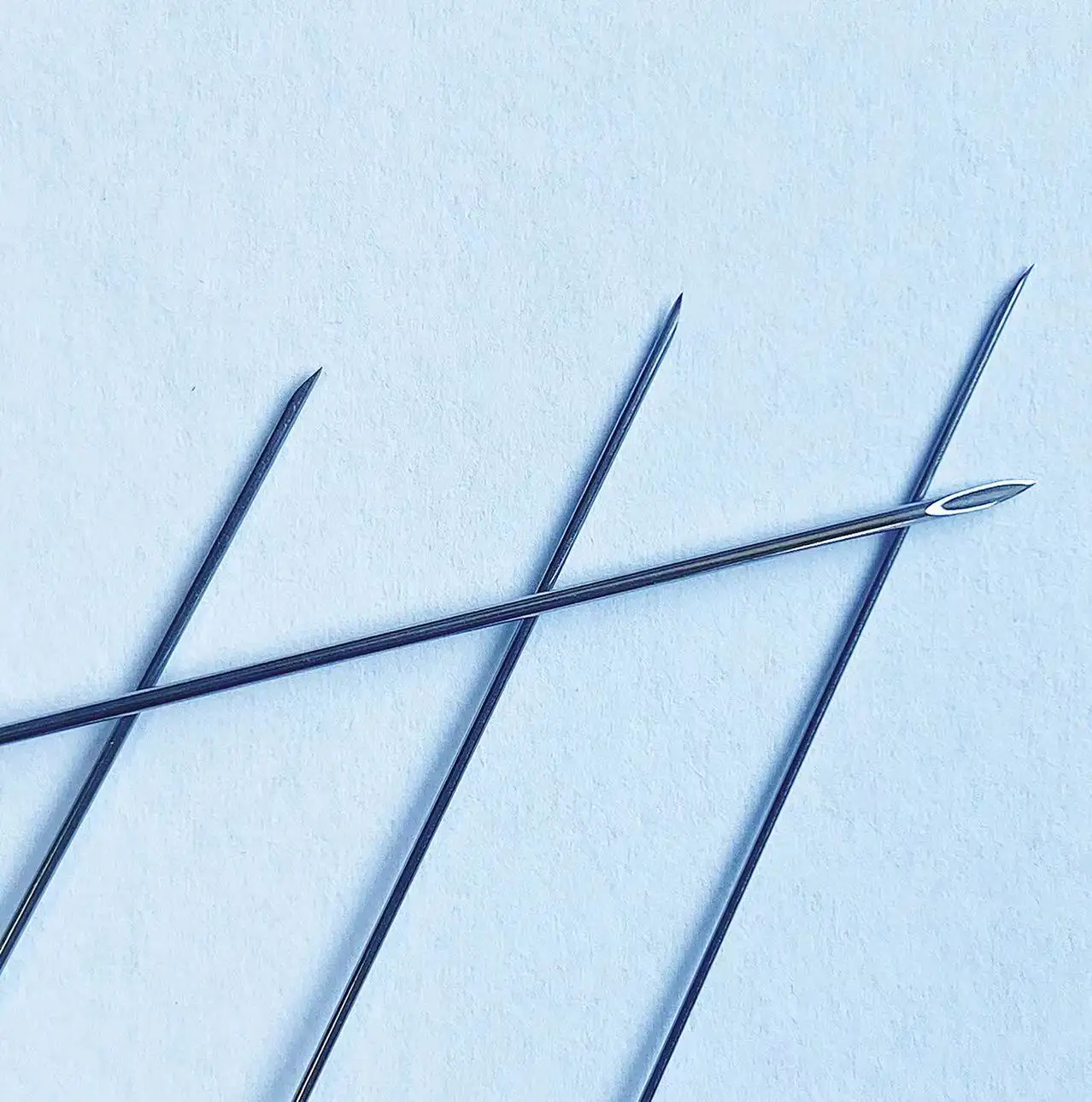ความสำคัญของการออกแบบเข็มในทางปฏิบัติการทางการแพทย์
ในวิสัญญีวิทยาสมัยใหม่ การออกแบบ เข็ม ที่ใช้ในการทำระดับยาชาผ่านทางหลังเยื่อหุ้มไขสันหลังมีบทบาทสำคัญต่อความปลอดภัยและความมีประสิทธิภาพ การเข้าถึงพื้นที่ที่ไวต่อความรู้สึกใกล้กับไขสันหลังนั้น แม้เพียงข้อผิดพลาดเล็กน้อยก็อาจนำไปสู่ภาวะแทรกซ้อนได้ การออกแบบเข็มที่เหมาะสมจะช่วยให้แพทย์สามารถดำเนินการขั้นตอนที่ละเอียดอ่อนนี้ได้อย่างแม่นยำ ลดความเสี่ยงต่อผู้ป่วยในขณะที่ยังคงให้การบรรเทาอาการปวดได้อย่างมีประสิทธิภาพ เมื่อแพทย์มีเครื่องมือที่เหมาะสม ผลลัพธ์ของผู้ป่วยจะดีขึ้นอย่างมาก และขั้นตอนต่าง ๆ จะมีความน่าเชื่อถือมากยิ่งขึ้น ดังนั้นการออกแบบเข็มจึงไม่ใช่เพียงแค่เรื่องความสะดวกเท่านั้น แต่ยังเป็นปัจจัยสำคัญต่อความสำเร็จในการรักษา
การเข้าใจเข็มสำหรับฉีดยาชาแบบเอพิดูรัล
คุณสมบัติทางโครงสร้างของเข็มเอพิดูรัล
หนึ่ง เข็มทางเยื่อหุ้มสมอง มีความแตกต่างจากเข็มทางการแพทย์ทั่วไปทั้งในด้านรูปร่างและหน้าที่ โดยทั่วไปเข็มชนิดนี้จะมีขนาดใหญ่กว่า มีปลายแหลมแบบเบเวลที่ออกแบบมาเพื่อช่วยนำท่อสายสวน (catheter) ให้เข้าสู่ช่องเอพิดูรัลอย่างปลอดภัย ตัวเข็มกลวงช่วยให้ยาชาหรือยาแก้ปวดสามารถไหลผ่านได้อย่างมีประสิทธิภาพ ในขณะที่ขีดบอกความลึกช่วยให้แพทย์สามารถควบคุมการสอดเข็มได้อย่างแม่นยำมากยิ่งขึ้น ด้ามจับของเข็มมีการออกแบบให้เหมาะกับหลักสรีรศาสตร์ (ergonomically shaped) เพื่อให้ควบคุมการสอดเข็มได้ดีขึ้น องค์ประกอบแต่ละส่วนของเข็มถูกออกแบบมาเพื่อลดข้อผิดพลาดและเพิ่มความแม่นยำ
วัตถุประสงค์ของการออกแบบเข็มเป็นพิเศษ
การออกแบบเข็มระบายเฉพาะเจาะจงนั้นคำนึงถึงความท้าทายในการทำงานใกล้ไขสันหลัง โดยขั้นตอนการให้ยาชาแบบรอบเยื่อหุ้มไขสันหลัง (epidural) ต้องการการวางตำแหน่งที่แม่นยำในพื้นที่แคบ ซึ่งต่างจากการฉีดยาทั่วไป ความลาดเอียง (bevel) เครื่องหมายบนเข็ม และความแข็งแรงของเข็มนั้นมีความสำคัญต่อการนำท่อสายสวน (catheters) เข้าไปอย่างปลอดภัย หากขาดคุณสมบัติเหล่านี้ในการออกแบบเข็ม ความเสี่ยงที่จะทำให้เยื่อหุ้มไขสันหลังทะลุหรือเนื้อเยื่อรอบข้างได้รับความเสียหายก็จะเพิ่มขึ้น การออกแบบเข็มให้เหมาะสมกับบทบาทเฉพาะนี้ ช่วยให้การปฏิบัติงานทางคลินิกมีความปลอดภัยและสม่ำเสมอ

ผลกระทบของรูปแบบการออกแบบเข็มต่อขั้นตอนการให้ยาชาแบบรอบเยื่อหุ้มไขสันหลัง
ความแม่นยำในการวางตำแหน่ง
การทำระงับด้วยการฉีดยาที่เยื่อหุ้มไขสันหลังให้ประสบผลสำเร็จนั้นขึ้นอยู่กับการสอดเข็มให้ถึงช่องระดับเยื่อหุ้มไขสันหลังด้วยความแม่นยำระดับมิลลิเมตร การออกแบบเข็มที่ไม่ดีจะเพิ่มความเสี่ยงในการสอดเข็มผิดตำแหน่ง ซึ่งอาจนำไปสู่การลดความเจ็บปวดที่ไม่สมบูรณ์หรือเกิดภาวะแทรกซ้อน คุณสมบัติเช่น สเกลบอกความลึกและปลายเข็มที่ตัดเอียงจะช่วยนำทางแพทย์ในระหว่างการสอดเข็ม เพื่อให้แน่ใจว่าเข็มอยู่ในตำแหน่งที่ถูกต้อง ความแม่นยำนี้มีความสำคัญไม่เพียงต่อประสิทธิภาพ แต่ยังรวมถึงความปลอดภัยของผู้ป่วยด้วย
การลดภาวะแทรกซ้อน
ภาวะแทรกซ้อน เช่น การเจาะเยื่อหุ้มไขสันหลังโดยไม่ได้ตั้งใจ ความเสียหายของเส้นประสาท หรือเลือดออก อาจเกิดขึ้นได้จากขั้นตอนที่ดำเนินการไม่ดี เข็มที่มีคุณสมบัติการออกแบบที่ทันสมัยสามารถช่วยลดความเสี่ยงเหล่านี้ได้ ตัวอย่างเช่น ปลายเข็มที่ตัดเอียงอย่างเรียบเนียนจะช่วยลดการบาดเจ็บของเนื้อเยื่อ ในขณะที่ความแข็งแรงที่เหมาะสมจะทำให้เข็มไม่เกิดการงอโค้งขึ้นโดยไม่คาดคิด การปรับปรุงด้านการออกแบบนี้ส่งผลโดยตรงต่อความปลอดภัยของผู้ป่วยที่ได้รับการให้ยาชา
ประโยชน์ของเข็มที่ออกแบบมาอย่างดี
เพิ่มความสะดวกสบายให้กับผู้ป่วย
การออกแบบเข็มที่เน้นการสอดใส่ได้อย่างราบรื่นและลดการบาดเจ็บนั้นเป็นประโยชน์ต่อผู้ป่วยอย่างมาก การออกแบบปลายเข็มที่มีความแม่นยำช่วยลดแรงต้านขณะสอดเข็ม ทำให้ผู้ป่วยรู้สึกไม่สบายตัวลดลง ความสามารถในการวางสายสวนโดยที่ไม่ต้องปรับมากนักยังช่วยเพิ่มประสบการณ์ของผู้ป่วยด้วย เมื่อผู้ป่วยรู้สึกเจ็บน้อยลงในระหว่างการดำเนินการ ความวิตกกังวลก็จะลดลงตามไปด้วย ส่งผลให้ความร่วมมือกับเจ้าหน้าที่ทางการแพทย์เป็นไปอย่างราบรื่น
ประสิทธิภาพสำหรับผู้ให้บริการด้านสุขภาพ
สำหรับแพทย์และพยาบาลแล้ว รูปแบบการออกแบบเข็มมีผลโดยตรงต่อประสิทธิภาพการทำงาน ด้ามจับที่ออกแบบมาตามหลักสรีรศาสตร์ เครื่องหมายบอกความลึกที่มองเห็นได้ชัดเจน และความแข็งแรงที่เชื่อถือได้ ช่วยให้กระบวนการทำงานรวดเร็วและคาดการณ์ผลได้ดีขึ้น ประสิทธิภาพเช่นนี้มีคุณค่าอย่างยิ่งในสภาพแวดล้อมของโรงพยาบาลที่มีความเร่งด่วน เพราะทั้งเวลาและความแม่นยำมีความสำคัญเท่าเทียมกัน การลดจำนวนครั้งที่ต้องพยายามเพื่อหาตำแหน่งที่ถูกต้อง ยังช่วยลดความเสี่ยงของภาวะแทรกซ้อนโดยรวมได้ด้วย
ปัญหา และ ข้อ พิจารณา
ความจำเป็นในความเชี่ยวชาญทางคลินิก
แม้เข็มที่ถูกออกแบบมาอย่างดีที่สุดก็ยังคงต้องการผู้เชี่ยวชาญในการใช้งาน แพทย์ต้องได้รับการฝึกอบรมเพื่อให้เข้าใจเกี่ยวกับสรีระของกระดูกสันหลังและวิธีใช้เข็มอย่างเหมาะสม การออกแบบอาจสามารถช่วยนำทางและอำนวยความสะดวก แต่ทักษะความเชี่ยวชาญเท่านั้นที่จะรับประกันการวางเข็มในตำแหน่งที่ถูกต้องและการส่งยาอย่างปลอดภัย หากไม่มีการฝึกอบรมที่เพียงพอ ฟีเจอร์อันทันสมัยของเข็มก็ไม่อาจลดความเสี่ยงได้อย่างสมบูรณ์
ความแตกต่างระหว่างประชากรผู้ป่วย
ผู้ป่วยแต่ละรายมีความท้าทายที่แตกต่างกัน ผู้ป่วยที่มีภาวะโรคอ้วน ความผิดปกติของกระดูกสันหลัง หรือเคยผ่านการผ่าตัดมาก่อน อาจทำให้การใส่สายระดับหลังยากขึ้น ดีไซน์ของเข็มต้องสามารถรองรับความแตกต่างเหล่านี้ไว้ได้ในขณะที่ยังคงให้ผลลัพธ์ที่เชื่อถือได้ ผู้ผลิตยังคงพัฒนาคุณสมบัติของเข็มให้เหมาะสมกับกลุ่มผู้ป่วยที่หลากหลายมากยิ่งขึ้น แต่การตัดสินใจทางคลินิกยังคงเป็นสิ่งสำคัญยิ่ง
นวัตกรรมในดีไซน์ของเข็ม
การเพิ่มความปลอดภัยในเข็มรุ่นใหม่
นวัตกรรมล่าสุดมุ่งเน้นการปรับปรุงความปลอดภัย โดยเข็มบางชนิดในปัจจุบันมีระบบให้ข้อมูลการมองเห็นหรือการสัมผัสที่ช่วยให้แพทย์สามารถตรวจสอบได้ว่าเข็มได้เข้าสู่ตำแหน่งที่ถูกต้องแล้ว อีกประเภทหนึ่งมีผนังที่เสริมความแข็งแรงเพื่อป้องกันการงอหรือหักในระหว่างการใช้งาน ความก้าวหน้าเหล่านี้แสดงให้เห็นถึงความสำคัญของการพัฒนาเทคโนโลยีเข็มสำหรับขั้นตอนการให้ยาชาแบบอีพิดูรัล (Epidural) อย่างต่อเนื่อง
การผสานรวมกับเครื่องมือภาพถ่ายและระบบนำทาง
แนวโน้มอีกอย่างหนึ่งคือการผสานการใช้งานเข็มกับเครื่องมืออัลตราซาวด์หรือระบบนำทางดิจิทัล เมื่อใช้ร่วมกับเครื่องมือถ่ายภาพสมัยใหม่ เข็มที่มีการทำเครื่องหมายความลึกและเพิ่มความชัดเจนในการมองเห็น ช่วยให้แพทย์เห็นตำแหน่งที่แน่นอนของเข็มขณะทำการสอดใส่ การรวมการออกแบบและเทคโนโลยีเข้าด้วยกันนี้สามารถลดข้อผิดพลาดและเพิ่มความปลอดภัยให้กับผู้ป่วยได้อย่างมาก
บทบาทของการออกแบบเข็มในกลยุทธ์การจัดการอาการปวด
การประยุกต์ใช้ในศัลยกรรมและการคลอดบุตร
การออกแบบเข็มส่งผลโดยตรงต่อผลลัพธ์ของการผ่าตัดและการคลอดบุตร ในระหว่างการคลอด เข็มฉีดเข้าช่องไขสันหลังจะช่วยบรรเทาอาการปวดได้อย่างมีประสิทธิภาพ ช่วยให้มารดายังคงรู้สึกตัวและลดความทุกข์ทรมาน ในการผ่าตัดที่เกี่ยวข้องกับช่องท้องส่วนล่างหรือแขนขา ความแม่นยำของเข็มช่วยให้มั่นใจได้ว่าการให้ยาสลบจะมีประสิทธิภาพโดยปราศจากความเสี่ยงจากการดมยาสลบ การออกแบบที่ดีขึ้นหมายถึงภาวะแทรกซ้อนที่น้อยลงและผู้ป่วยฟื้นตัวได้เร็วขึ้น
การใช้งานในด้านการรักษาอาการปวดเรื้อรัง
นอกเหนือจากการดูแลรักษาอาการฉุกเฉิน ดีไซน์ของเข็มยังมีความสำคัญในการจัดการอาการปวดระยะยาว สำหรับผู้ป่วยที่ต้องการฉีดยาเข้าขั้วหลังซ้ำๆ เข็มที่มีประสิทธิภาพจะช่วยให้การรักษาสม่ำเสมอ และลดการบาดเจ็บจากรอบหลายครั้ง การรักษาอาการปวดเรื้อรังจะได้รับประโยชน์จากความแม่นยำและความปลอดภัยที่การออกแบบเข็มยุคใหม่สามารถมอบให้ ทำให้เข็มเป็นหนึ่งในหัวใจสำคัญของยุทธศาสตร์การจัดการอาการปวดขั้นสูง
คำถามที่พบบ่อย
อะไรที่ทำให้เข็มระงับปวดทางหลังแตกต่างจากเข็มมาตรฐาน
เข็มเพื่อฉีดยาชาแบบอีพิดูรัลมีปลายที่ออกแบบพิเศษ มีขนาดใหญ่กว่า และมีขีดบอกความลึกเพื่อช่วยในการสอดเข้าไปยังตำแหน่งที่ต้องการ คุณสมบัติเหล่านี้มีความสำคัญอย่างมากในการเข้าถึงช่องอีพิดูรัลอย่างปลอดภัยและแม่นยำ ต่างจากเข็มธรรมดา
การออกแบบเข็มช่วยเพิ่มความปลอดภัยให้กับผู้ป่วยอย่างไร
การออกแบบเข็มช่วยลดภาวะแทรกซ้อน เช่น การเจาะเยื่อหุ้มสมองหรือการบาดเจ็บของเส้นประสาท โดยเพิ่มความแม่นยำและลดการบาดเจ็บของเนื้อเยื่อ คุณสมบัติเพื่อความปลอดภัย เช่น ความแข็งแรงของเข็ม มุมปลายเข็ม และตัวบอกความลึก มีส่วนช่วยให้ผลลัพธ์การรู้ดีขึ้น
เข็มทุกชนิดสามารถใช้สำหรับการทำอีพิดูรัลได้หรือไม่
ไม่ ควรใช้เฉพาะเข็มอีพิดูรัลที่ออกแบบมาโดยเฉพาะเท่านั้น เข็มธรรมดาไม่มีโครงสร้างและคุณสมบัติที่จำเป็นในการเข้าถึงช่องอีพิดูรัลอย่างปลอดภัย ซึ่งอาจเพิ่มความเสี่ยงต่อผู้ป่วย
นวัตกรรมใหม่ๆ ในการออกแบบเข็มสามารถลดความเสี่ยงจากการให้ยาสลบได้หรือไม่
ได้ ด้วยการออกแบบใหม่ๆ เช่น ด้ามจับที่เหมาะกับสรีระ เพิ่มความแข็งแรงของแกนเข็ม และรองรับการทำงานร่วมกับเครื่องมือภาพถ่ายทางการแพทย์ ช่วยให้การทำหัตถการมีความปลอดภัยและเชื่อถือได้มากขึ้น ลดความเสี่ยงในระหว่างการให้ยาสลบ
สารบัญ
- ความสำคัญของการออกแบบเข็มในทางปฏิบัติการทางการแพทย์
- การเข้าใจเข็มสำหรับฉีดยาชาแบบเอพิดูรัล
- ผลกระทบของรูปแบบการออกแบบเข็มต่อขั้นตอนการให้ยาชาแบบรอบเยื่อหุ้มไขสันหลัง
- ประโยชน์ของเข็มที่ออกแบบมาอย่างดี
- ปัญหา และ ข้อ พิจารณา
- นวัตกรรมในดีไซน์ของเข็ม
- บทบาทของการออกแบบเข็มในกลยุทธ์การจัดการอาการปวด
- คำถามที่พบบ่อย

